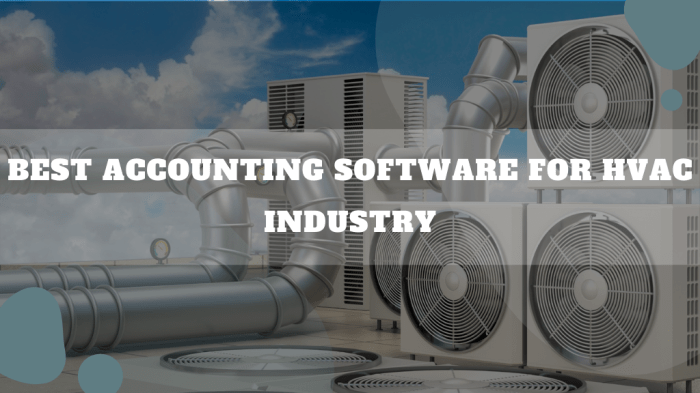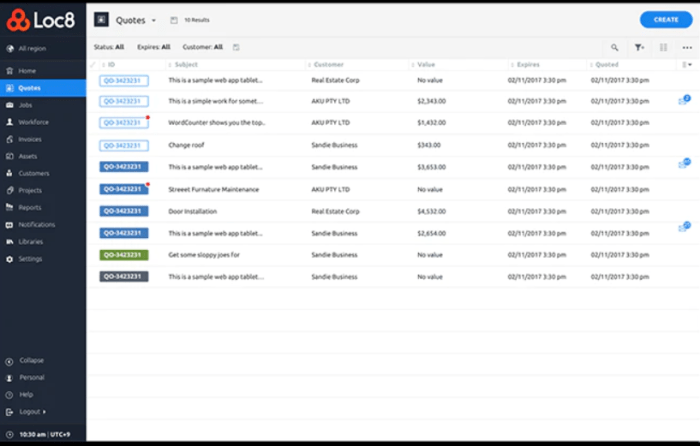In the modern business landscape, seamless integration between various software systems is crucial for efficient operations. HVAC software that seamlessly integrates with accounting systems is no exception. By bridging the gap between these two critical systems, businesses can streamline data flow, improve accuracy, and make informed decisions.
Integrating HVAC software with accounting systems offers numerous benefits, including enhanced financial reporting, streamlined data management, and optimized operational decision-making. This comprehensive guide will delve into the advantages, challenges, best practices, and case studies of HVAC software integration with accounting systems.
Overview of HVAC Software Integration with Accounting Systems
Integrating HVAC software with accounting systems offers numerous advantages, including streamlined operations, improved data accuracy, and enhanced financial control. By seamlessly connecting these two systems, businesses can automate tasks, reduce errors, and gain a comprehensive view of their financial performance.
Some notable examples of HVAC software that integrate with accounting systems include ServiceTitan, FieldEdge, and JobNimbus. These solutions provide robust features and functionalities tailored to the specific needs of HVAC businesses.
Key Features and Functionalities
- Automated Invoicing and Billing: Integration enables automatic generation and sending of invoices based on work orders and service records, eliminating manual data entry and reducing the risk of errors.
- Real-Time Financial Data: HVAC software integrates with accounting systems to provide real-time visibility into financial data, allowing businesses to monitor cash flow, track expenses, and make informed decisions.
- Job Costing and Tracking: The integration facilitates accurate job costing and tracking, enabling businesses to analyze profitability, identify areas for improvement, and optimize resource allocation.
- Customer Relationship Management (CRM): Integration with accounting systems enhances CRM capabilities, allowing businesses to track customer interactions, manage contracts, and provide personalized service.
- Reporting and Analytics: HVAC software integrated with accounting systems provides comprehensive reporting and analytics capabilities, enabling businesses to gain insights into their financial performance, identify trends, and make data-driven decisions.
Benefits of Integrating HVAC Software with Accounting Systems
Integrating HVAC software with accounting systems offers numerous advantages that streamline data flow and enhance financial management.
Improved Accuracy and Efficiency in Financial Reporting
By automating the exchange of data between HVAC and accounting systems, businesses can eliminate manual data entry errors and improve the accuracy of financial reporting. This reduces the risk of errors and discrepancies, ensuring reliable and up-to-date financial information.
Enhanced Operational Decision-Making
Integrated HVAC and accounting systems provide a comprehensive view of business operations, enabling decision-makers to make informed decisions based on real-time data. By tracking key metrics such as energy consumption, maintenance costs, and equipment performance, businesses can identify areas for improvement and optimize resource allocation.
Streamlined Billing and Payment Processing
Integration allows for seamless billing and payment processing, eliminating the need for manual data entry and reducing the risk of errors. Automated invoicing and payment tracking ensure timely payments and improve cash flow management.
Challenges of Integrating HVAC Software with Accounting Systems

Integrating HVAC software with accounting systems can present challenges due to data compatibility and standardization issues. Data compatibility ensures that data can be easily transferred and interpreted between different systems, while standardization refers to the use of common data formats and structures.
Data Compatibility
HVAC software and accounting systems often use different data formats and structures, making it difficult to exchange data accurately. This can lead to errors and inconsistencies in financial reporting. To overcome this challenge, data mapping and transformation techniques can be used to convert data from one format to another.
Data Standardization
The lack of standardization in HVAC software and accounting systems can further complicate integration. Different vendors may use proprietary data formats, making it difficult to integrate their systems with third-party applications. Adopting industry-standard data formats, such as XBRL or EDI, can facilitate seamless data exchange and integration.
Recommendations for Overcoming Integration Challenges
To overcome integration challenges, it is important to:
- Identify data compatibility and standardization issues early in the integration process.
- Establish clear data mapping and transformation rules to ensure accurate data transfer.
- Adopt industry-standard data formats to facilitate seamless integration.
- Work closely with software vendors to ensure compatibility and support.
- Regularly test and validate the integration to identify and resolve any issues.
By addressing these challenges, organizations can ensure successful integration of HVAC software with accounting systems, leading to improved data accuracy, efficiency, and financial reporting.
Best Practices for Integrating HVAC Software with Accounting Systems
Integrating HVAC software with accounting systems can significantly enhance operational efficiency and streamline financial management. To ensure a successful integration, it is crucial to follow best practices that emphasize planning, preparation, and a systematic approach.
Importance of Planning and Preparation
Thorough planning and preparation are essential for a successful integration. This involves clearly defining the integration goals, identifying the specific data to be shared between the systems, and determining the integration points. Additionally, it is important to establish a clear timeline for the integration process and assign responsibilities to team members.
Step-by-Step Guide to the Integration Process
The integration process typically involves the following steps:1.
-
-*Data Mapping
Define the specific data fields that need to be shared between the HVAC software and the accounting system. This includes mapping customer information, job details, equipment data, and financial transactions.
- 2.
- 3.
- 4.
- 5.
-*System Configuration
Configure both the HVAC software and the accounting system to enable data exchange. This may involve setting up API connections, creating custom fields, or modifying existing data structures.
-*Data Migration
Transfer the necessary data from the HVAC software to the accounting system. This can be done manually or through automated data migration tools.
-*Testing and Validation
Thoroughly test the integration to ensure that data is flowing seamlessly between the systems and that all processes are functioning as expected.
-*Training and Support
Provide training to users on how to utilize the integrated system effectively. Establish a support plan to address any issues that may arise after the integration.
Case Studies of Successful HVAC Software Integration with Accounting Systems
Integrating HVAC software with accounting systems can bring significant benefits to HVAC businesses.
Here are a few case studies that demonstrate the successful implementation of such integrations:
Case Study 1: ABC HVAC Company
ABC HVAC Company, a leading provider of HVAC services in the Midwest, integrated its HVAC software with its QuickBooks accounting system. The integration allowed the company to automate its billing and invoicing processes, reducing errors and saving time. Additionally, the integration provided the company with real-time visibility into its financial performance, enabling it to make better decisions.
Challenges and Solutions
One of the challenges faced by ABC HVAC Company during the integration process was ensuring that the data from the two systems was synchronized. The company solved this challenge by using a third-party integration tool that automatically mapped data between the two systems.
Benefits and Outcomes
The integration of HVAC software with the accounting system resulted in several benefits for ABC HVAC Company, including:* Reduced billing errors
- Improved cash flow
- Increased efficiency
- Enhanced financial reporting
Case Study 2: XYZ HVAC Company
XYZ HVAC Company, a large commercial HVAC contractor, integrated its HVAC software with its SAP accounting system. The integration allowed the company to streamline its project management processes, reducing costs and improving customer satisfaction. Additionally, the integration provided the company with better control over its inventory and equipment, resulting in reduced waste and increased profitability.
Challenges and Solutions
One of the challenges faced by XYZ HVAC Company during the integration process was the complexity of the SAP accounting system. The company solved this challenge by working with a team of experienced consultants who had expertise in both HVAC software and SAP.
Benefits and Outcomes
The integration of HVAC software with the accounting system resulted in several benefits for XYZ HVAC Company, including:* Reduced project costs
- Improved customer satisfaction
- Increased inventory control
- Enhanced profitability
These case studies demonstrate the potential benefits of integrating HVAC software with accounting systems. By automating processes, improving data accuracy, and providing real-time visibility into financial performance, these integrations can help HVAC businesses improve their efficiency, profitability, and customer satisfaction.
Last Recap

In conclusion, integrating HVAC software with accounting systems is a strategic move that empowers businesses to operate more efficiently and make data-driven decisions. By overcoming integration challenges, following best practices, and leveraging successful case studies, businesses can unlock the full potential of this integration.
Ultimately, it enhances financial accuracy, streamlines operations, and provides a competitive edge in the dynamic business environment.
Frequently Asked Questions
What are the key benefits of integrating HVAC software with accounting systems?
Integrating HVAC software with accounting systems offers several key benefits, including streamlined data flow, improved accuracy in financial reporting, and enhanced operational decision-making.
What are some challenges that businesses may face when integrating HVAC software with accounting systems?
Potential challenges include data compatibility issues, lack of standardization, and the need for proper planning and preparation. However, these challenges can be overcome with careful planning and the adoption of best practices.
What are the best practices for successful integration of HVAC software with accounting systems?
Best practices include thorough planning, data standardization, and a step-by-step integration process. Regular maintenance and updates are also essential to ensure ongoing success.